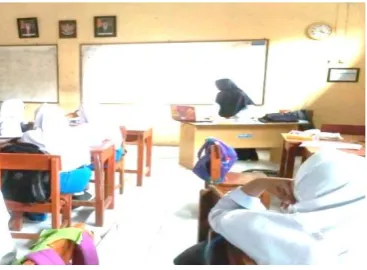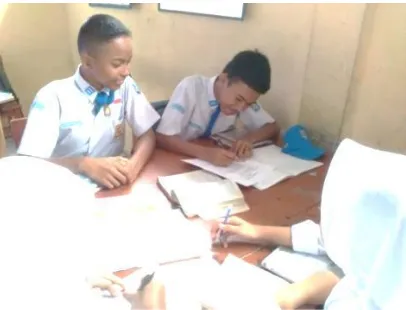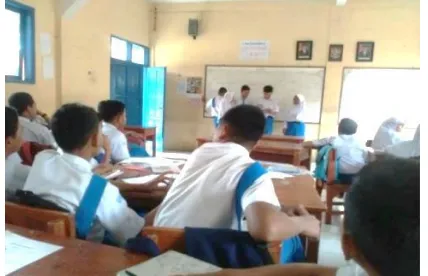Volume 7, No. 2, September 2018 e–ISSN 2460-9285
1,2 Institut Keguruan dan Ilmu Pendidikan Siliwangi, Jl. Terusan Jenderal Sudirman, Cimahi, Indonesia 1 [email protected], 2 [email protected]
Received: May 08, 2018 ; Accepted: July 05, 2018
Abstract
This research is motivated by the low ability of mathematics understanding of junior high school students, with the aim of the study is to examine the achievement, improvement, implementation, and difficulty of mathematics understanding ability of junior high school students through learning using Geogebra-assisted scientific approach. The method of this research is an experimental method with two class groups namely experimental class and control class. The population of this research is all junior high school in West Bandung Regency, randomly selected and selected SMP Krida Utama Padalarang. Samples were taken randomly class VIII chosen D as an experimental class, and class VIII C as control class. The experimental level received learning with the Geogebra-assisted scientific approach, and the control class gained regular learning. The results showed that the achievement and improvement of the ability of mathematical understanding between students who received learning with scientific approach assisted Geogebra software better with students who get regular learning. Learning with Geogebra-assisted scientific approach can be implemented in the experimental class by the steps of the scientific method of observing, asking, exploring, associating, and communicating. Keywords: Geogebra, Mathematical Understanding, Scientific Approach.
Abstrak
Penelitian ini dilatarbelakangi oleh rendahnya kemampuan pemahaman matematik siswa SMP. Tujuan penelitian ini adalah menelaah pencapaian, peningkatan, implementasi, serta kesulitan kemampuan pemahaman matematik siswa SMP melalui pembelajaran menggunakan pendekatan saintifik berbantuan software Geogebra. Metode penelitian ini adalah eksperimen dengan dua kelompok yaitu kelas eksperimen dan kelas kontrol. Populasi penelitian ini adalah seluruh SMP di Kabupaten Bandung Barat, dipilih secara acak dan terpilih SMP Krida Utama Padalarang. Sampel diambil secara acak kelas terpilih kelas VIII D sebagai kelas eksperimen, dan kelas VIII C sebagai kelas kontrol. Kelas eksperimen memperoleh pembelajaran dengan pendekatan saintifik berbantuan software Geogebra, dan kelas kontrol memperoleh pembelajaran biasa. Hasil penelitian menunjukkan bahwa pencapaian dan peningkatan kemampuan pemahaman matematik antara siswa yang memperoleh pembelajaran dengan pendekatan saintifik berbantuan software Geogebra lebih baik dengan siswa yang memperoleh pembelajaran biasa. Pembelajaran dengan pendekatan saintifik berbantuan software Geogebra dapat diimplementasikan di kelas eksperimen sesuai dengan langkah-langkah pendekatan saintifik yaitu mengamati, menanya, mengeksplorasi, mengasosiasi, dan mengkomunikasi.
Kata Kunci: Geogebra, Pemahaman Matematik, Pendekatan Saintifik.
How to Cite: Rohaeti, E. E., & Bernard, M. (2018). The Students’ Mathematical
INTRODUCTION
Mathematics is a compulsory subject in every formal education from the lowest level to the highest level of education, be it simple math or complex mathematics. Mathematics is a subject universal (comprehensive) because according to Chotimah, Bernard, & Wulandari, (2018) mathematics needs to be given to students from elementary school to a high level of cultivation. In the 2006 KTSP enhanced in the Curriculum 2013 that the purpose of learning mathematics is Understanding the concept of mathematics; Using reasoning on patterns and attitudes; Students can manipulate mathematics and generalize, present evidence, or explain mathematical ideas and statements; Students can solve Mathematics problems; 4) communicating mathematical symbols; 5) have an appreciation of the usefulness of mathematics in the life of curiosity, attention, and interest in learning mathematics, such as resilience and confidence in problem-solving (Hidayat & Sariningsih, 2018).
Referring to the objectives of mathematics learning above shows why the ability of mathematical understanding is important to be possessed by students because the knowledge of understanding is the underlying ability of a student in education. Mathematics is not about how students memorize formulas that can have a negative impact on students, but mathematics is about how students can understand basic concepts that support their knowledge in learning new, more complex materials (Bernard & Rohaeti, 2016).
In Curriculum 2006 (Sugiman, 2008), that indicator ability of understanding that is: 1) reiterating a concept; 2) classify objects according to certain traits (in accordance with the idea); 3) provide examples and non examples of ideas; 4) presents concepts in various forms of mathematical representation; 5) develop sufficient requirements or sufficient terms of a concept; 6) using, utilizing, and selecting certain procedures or operations; 7) apply the idea or problem-solving algorithm.
Referring to an indicator of the ability to comprehend, it indicates that the comprehension ability needs to be possessed by each student, be it elementary school students as well as intermediate level. Based on the four stages of the theory of cognitive development according to Piaget (Ruseffendi, 2010) that the formal operation stage is the age range of children from 11 years to adulthood, showing junior high school students is an early stage students must be able to understand something abstract, and process information it becomes a concrete matter that can be recognized. Difficulties students to mathematics in general due to the number of formulas that need to be known by students to be able to solve a problem. This happens on the basis of the students' habits, either from themselves or from the teacher's encouragement to memorize the formula instead of understanding the concepts of the material being studied, so that students find it difficult when given the exercise due to forgetting the formula that has been memorized, then the statement that mathematics is difficult to be asked by students . According to Sumarmo (Fuadi, Johar, & Munzir, 2016), that students' scores of comprehension and mathematical reasoning are still low. Students are still experiencing difficulties in relational understanding and second-degree thinking. This indicates that students' understanding ability is still quite low.
Based on one of the indicators of the ability of understanding that students are expected to be able to present the concept in various forms of mathematical representation by involving potential cognitive processes in stimulating intellect development, from simple ideas to more complex, a structured learning approach is needed discussing simple concepts to more complex concepts, ranging from students to new learning materials until they can communicate their learning outcomes in presentation activities in front of the classroom in order to facilitate the students to understand the learning materials presented by the teacher.
The scientific approach is a scientific framework promoted by the 2013 curriculum. According to Hendriana, Rohaeti, & Hidayat (2017), the steps of the Scientific Approach in the learning process involve digging information through observation, inquiring, experimenting, then processing data or information, presenting data or information, followed by analyzing, reason, they conclude, and create. Through the instructional steps that the expert conveys in a scientific approach, students are directed to observe directly what is being learned, ask questions based on observations, try/gather information, process information, deliver, even at the end of the student's learning to create/produce a product.
Encouraged by the rapid development of technology and information at this time, learning by using scientific approach can be collaborated with computer media application Geogebra, because through this application students can learn various mathematics materials at once, even students can try to operate itself because this application is free application not paid, and can use Bahasa Indonesia and comfortable in operation. Seeing the fact in the field that the ability of mathematical understanding needs to be optimized early and the development of ICT in the area of education to apply the concept of mathematics, the researchers intend to conduct research explicitly aimed at junior high school students (Chotimah, et al., 2018).
METHOD
The method used in this study is an experimental method, two class groups is one group of a control class and one group of experiment class. Both groups of courses are given pretest and posttest. As a form of treatment, the control class group acquired the teaching of mathematics in the usual way, while the experimental class obtained the learning of mathematics using a scientific approach with the help of GeoGebra software.
According to Ruseffendi (2010), based onthe type of experimental design that is the selection of random class groups (A), the pretest (0) in the control class and experimental class, and the posttes (0) in both classes, called the pretest-posttest control group design, with the research design for each class group as follows:
RESULTS AND DISCUSSION
The results obtained from the students in the form of the comprehension of students' understanding before and after being given learning from both classes, namely the experimental class and the control class. Where, before the two classes there was no significant difference in average grade values, this was based on the processing of statistical data in the description that flat The values of the experiment and the experimental class were 4.85 and the control class was 5.15 with the standard deviation of 1.39 and 2.59, respectively. Then the results of the two results are compared using normal tests, and the results show a significant value <0.05 which means that the two data are not normal followed by a non-parametric test Mann - Whitney, the significant result is 0.80> 0.05 indicating no average differences between the two class at pretest. However, when posttest, in gain, the values of both classes have increased by showing positive values for the experimental gain average 0.54 and 0.445 control class, where the gain of the experimental class is higher than the control class class and based on the description that the average value at posttest for the class experiment 13.00 and for control class 11.71 with each standard deviation 2.702 and 2.59, after being tested normally, the results of significant values 0.000 and 0.015 means that both are significant <0.05, then followed by the non-parametric Mann-Whitney average difference test with a significant value of 0.016 <0.05 means that the experimental class whose learning uses geogebra software is better than ordinary learning to improve the mathematical comprehension ability of junior high school students, this is in line with Senjayawati & Bernard (2018) that learning mathematics that uses geogebra is better than learning in the normal way.
Learning process using the approach This science consists of five general steps: observing, questioning, exploring, associating, and communicating. In applying these five learning steps, in the process of learning researchers assisted by Geogebra software with the aim to facilitate researchers in delivering materials to students. The learning process in the experimental class by using-assisted-scientific approach is Geogebra software described with the steps of the activity.
Figure 1. Theresearcher gives the picture or object using GeoGebra software aid
to start the learning process (Observing Activity)
The characteristic of the scientific approach that emerges in this activity is to involve potential cognitive processes in stimulating intellectual development, in which students get an external stimulus in the form of an object displayed, intending to encouraging students' cognitive abilities and intellectual development.
Figure 2. Students ask questions by the object that has been observed (Activities Questioner)
After doing activities observing the object that has been submitted by the researcher, then the researchers continue the learning step of the scientific approach that is the activity of the question. Questioning activity is a learning process done after students observe an object by the material that has been studied.
In the questioning activities, researchers allow students to submit questions by the object that has been observed. Characteristics that emerged in this activity is student-centered learning because in the learning process teachers invite students to ask questions by what they observed in the classroom environment as well as on objects that teachers draw in Geogebra
software.
Figure 3. Students collect information from various sources whether
it is their knowledge, or from the source book (Activity Exploring)
Figure 4. Students process information obtained from observation and exploration activities (Association)
This activity is a student activity in processing the information they have collected. In this activity, students try and learn in groups to process concrete information in the form of concepts that have been presented by the teacher in observing activities and activities when collecting information from various sources that support learning activities to the more abstract.
Figure 5. Students present the results obtained at the time of processing information (Activities Communicate)
In this activity students in groups communicate/present results obtained at the time of processing information during the learning process. The material presented each group by the student worksheet which has been discussed by students in groups.
Each student is allowed to respond, refute, or add the explanation of a friend who is presenting. Each group takes turns presenting the results of the group's work in front of the class. In this activity, researchers direct students to be able to appreciate friends who are talking and mutual respect in differences of opinion.
Table 1. Results Value of Students' Mathematical Understanding Questions control class can show in problem number 1 many students who have the highest score of the experimental class more students, namely 19 students compared to the control class there are 13 students who master the problem. For problem number 2, there were 6 students in the experimental class who controlled more than the students in the control class there was 1 student. Likewise, for numbers 3, 4 and 5, the experimental class students have more control than the control class. With results based on the difficulties, students work on the ability to understand that the class that uses geogebra software is more mastering the material than the class that learns the normal way (Hendriana et al., 2017; Hidayat & Sariningsih, 2018).
CONCLUSION
Based on the results of research to determine the improvement of the ability of mathematical understanding of junior high school students using scientific-assisted approach Geogebra
software can be summed up things as follows Achievement of students' understanding of
mathematical ability learning using-assisted scientific approach Geogebra better than the learning using the usual approach. Improvement of students' mathematical understanding ability whose learning using-assisted scientific approach Geogebra is better than learning using the usual approach.
REFERENCES
Bernard, M. (2014). Pengaruh pembelajaran dengan menggunakan multimedia macromedia falsh terhadap kemampuan penalaran matematik. In Prosiding Seminar Nasional
Pendidikan Matematika Program Pasca Sarjana STKIP Siliwangi Bandung, 1,
425-429).
Bernard, M., & Rohaeti, E. E. (2016). Meningkatkan kemampuan penalaran dan disposisi matematik siswa melalui pembelajaran kontekstual berbantuan game Adobe Flash CS 4.0 (CTL-GAF). Edusentris, 3(1), 85-94.
Chotimah, S., Bernard, M., & Wulandari, S. M. (2018). Contextual approach using VBA learning media to improve students’ mathematical displacement and disposition ability. In Journal of Physics: Conference Series, 948(1), 012025.
Fuadi, R., Johar, R., & Munzir, S. (2016). Peningkatkan kemampuan pemahaman dan penalaran matematis melalui pendekatan kontekstual. Jurnal Didaktik
Hendriana, H., Rohaeti, E. E., & Hidayat, W. (2017). Metaphorical Thinking Learning and Junior High School Teachers' Mathematical Questioning Ability. Journal on
Mathematics Education, 8(1), 55-64.
Hidayat, W., & Sariningsih, R. (2018). Kemampuan Pemecahan Masalah Matematis dan Adversity Quotient Siswa SMP Melalui Pembelajaran Open Ended. JNPM (Jurnal
Nasional Pendidikan Matematika), 2(1), 109-118.
Ruseffendi, E. T. (2010). Dasar-dasar penelitian pendidikan dan bidang non-eksata lainnya. Bandung: Tarsito.
Senjayawati, E., & Bernard, M. (2018). Penerapan model search-solve-create-share untuk mengembangkan kemampuan penalaran matematis berbantuan software Geogebra 4.4. MAJU: Jurnal Ilmiah Pendidikan Matematika, 5(1).



